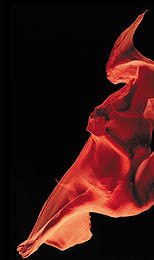
January 10, 2000
Butoh dance performance offers an evening of exquisite motion
Imagine actually observing a stalactite forming drip by drip, a constellation
navigating the sky, or sweet peas vining their way up a trellis. Of course it's impossible
to witness such subtle wonders but, through the evocative work of Butoh dancer Maureen
Fleming, one can experience them.
 |
| Maureen Fleming
performs "After Eros" on Friday, January 28, and Saturday, January 29, and
presents a workshop on motion on Saturday, January 29, in the Mainstage Theater.
Tickets are $16 adults; $13 seniors and students with ID; $8 UCSC students. For more
information, call (831) 459-2159. Photo: Ellen Crane |
When she comes to UCSC in January, Fleming will perform the show "After Eros," a piece she created in collaboration with composer Philip Glass and writer David Henry Hwang (author of the Tony award-winning play M. Butterfly). Fleming will also conduct a public workshop on motion on Saturday. Her visit is presented by UCSC Arts & Lectures.
Fleming has been dancing professionally for two decades. She trained classically before going to Japan to study Butoh. "One of the aims of Butoh is to tap into the primal energy of transformation," she explains. "Classical dance often gets mired in focusing on forms, whereas Butoh is always working to get to the place where this energy is alive."
To tap into that energy, Butoh dancers envision and evoke imagery; for example, Fleming says, a smoke ring moving up her back or elastic wrapped around her fingers. In many ways, Butoh is as kindred to sculpture as it is to dance. The performer takes a form or emotion and works through it--imagine what might have happened to Rodin's "Thinker" if he had finished his thought.
"Oftentimes my work is compared to Henry Moore and [Constantin] Brancusi," Fleming confirms. "I almost see myself more as a sculptor than a choreographer. I try to make images that really burn into someone's unconsciousness. It's a process of reducing movement to a symbol or an archetype: When my body becomes a circle, I want it to bring forth the unconscious of the observer."
In the stream of critical praise published on Fleming's show in the past three years, a common sentiment is often voiced--the impact of Fleming's performance lasts long after the house lights go up. Her burn is deep.
True to the transformative spirit of Butoh, Fleming's "After Eros" addresses a car accident she experienced as a child. Fleming was two years old at the time, living in Japan with her parents. As she describes it, "A man on a bicycle darted in front of our car, and when my mother slammed on the brakes I crashed into the windshield. My mother says that the man looked at us, laughed, and rode away."
Fleming had no memory of the accident, in which her sister was also injured, but a number of years ago when she was experiencing neck pain her doctor discovered a bone spur in her neck. "Ask your mother what happened to you as a child," he advised. When Fleming did, she learned of the accident.
It explained a lot. Ever since she can remember, Fleming has followed an instinct to dance and, long before she knew of Butoh, she had developed her own style of slow twisting motions--choreography that nursed her bone spur, preventing it from callusing and causing nerve damage.
"It was amazing to realize that all of my choreography had come out of that process of taking care of my neck," she marvels. And it is that process that she addresses in "After Eros"--how a source of pain can become a source of strength.
The "Eros" in the title refers to the mythological story of Eros and Psyche. The mortal woman, Psyche, is so beautiful that she is being worshipped in place of Aphrodite. A jealous Aphrodite orders her son, Eros, to make Psyche fall in love with the ugliest man in the world. Instead, Eros is pricked by his own arrow and falls in love himself.
Psyche is told by an oracle that she will never marry a mortal but must go live on a mountaintop with a horrible monster. She accepts her fate and goes to Eros's palace and falls in love with him. Eros forbids Psyche to look on his face and when she sneaks a look one evening he is infuriated by her betrayal and abandons her. Psyche (whose name means "soul" in Greek) accomplishes three impossible trials set for her by Aphrodite, winning the sympathy of the gods. She and Eros reunite and she is granted the gift of immortality. Hwang summarizes the story poetically in his text when Psyche says, "I have become the one whose love I sought."
For Fleming, the engaging theme in the story is that of attaining wholeness by facing and embracing one's tragedy. "We've all had those tragedies, it's what we do with them that matters. For me, it was being sent through the window and achieving transformation through that experience. I want this performance to give people hope for their own life and to face their own tragedies, to be open to the possibility of transformation through tragic experiences."